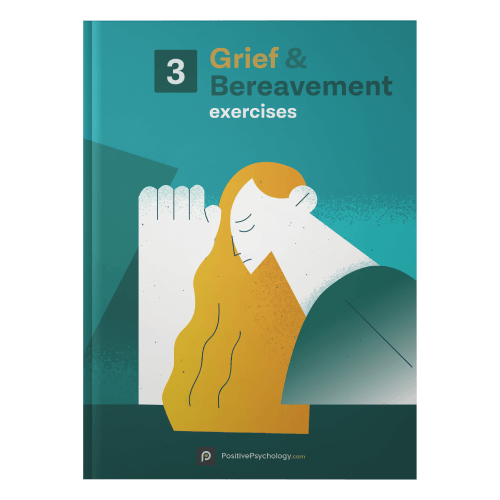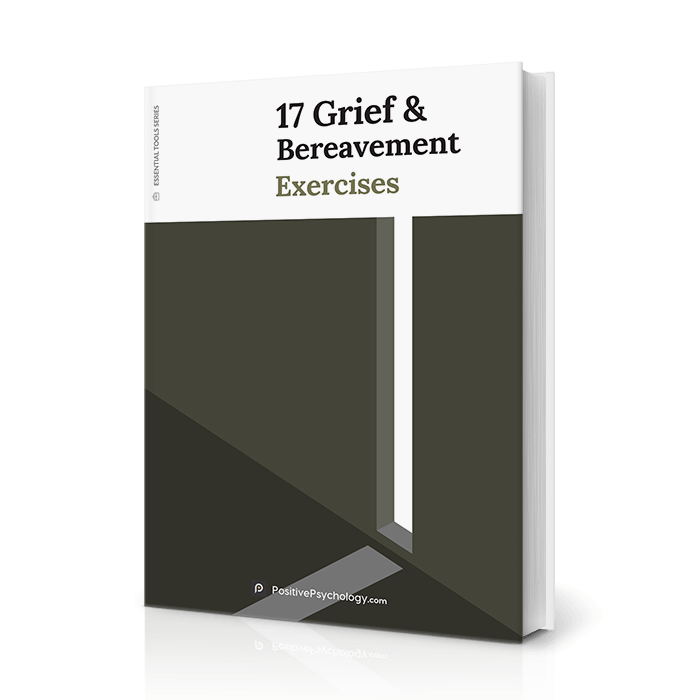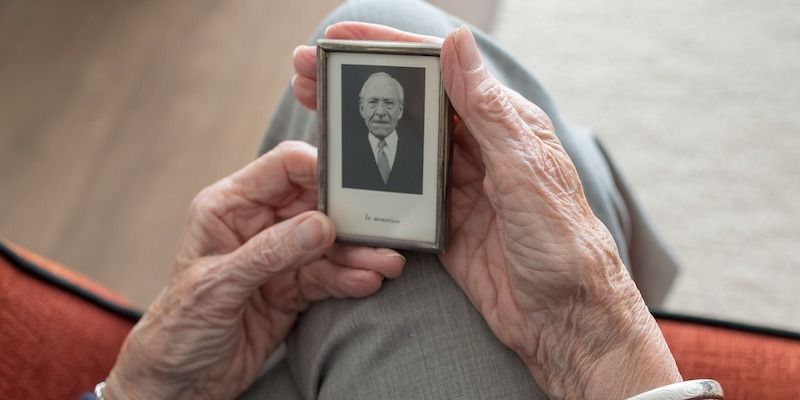Grief Meditation and Yoga: Healing Through Awareness
 The grief of bereavement is a severe psychosocial stressor (Stroebe, Schut, & Stroebe, 2007).
The grief of bereavement is a severe psychosocial stressor (Stroebe, Schut, & Stroebe, 2007).
Intense emotional pain can lead to substance abuse, relationship difficulties, anxiety, depression, and suicidal ideation (Von Korff et al., 2001). Unresolved grief can even have a detrimental effect on brain functioning (Rosnick, Small, McEvoy, Borenstein, & Mortimer, 2007).
If you are interested in helping bereaved clients and have some experience with yoga, you may wish to teach grief yoga. Meditation and yoga can really help clients rid themselves of the pain that follows loss and get out of the depths of distress.
This article will help your clients put the practicalities in place. You’ll also find excellent meditation scripts and yoga poses and learn exactly how and why these help alleviate grief.
Before you continue reading, we thought you might like to download our three Grief Exercises [PDF] for free. These science-based tools will help you move yourself or others through grief in a compassionate way.
This Article Contains:
How to Cope With Grief Through Meditation
Meditation cannot eradicate grief, but it can change how suffering is perceived. Practicing meditation for grief helps the body and mind find peace in difficult times.
Meditation can help with a variety of symptoms associated with grief, such as insomnia, physical pain, difficult emotions, and poor concentration (Bonanno & Kaltman, 2001). Meditation allows us to focus, concentrate, and develop compassion for ourselves and others (Desbordes et al., 2012). Meditation promotes immune functioning and overall health (Black & Slavich, 2016).
Just as physical exercise strengthens the body, meditation is akin to mental exercise and strengthens the brain (Desbordes et al., 2012). Meditation is like mind control and focuses the mind, stopping it from wandering aimlessly, and it requires practice.
Meditation allows grieving individuals to honor the relationship with the person they have lost. It helps incorporate positive memories into life after the loss. It might not be an easy task if the relationship was complex, though, as it is crucial to acknowledge painful emotions and work with the experiences of anger and regret.
Learning the techniques of meditation, the mind can be controlled in grief to reduce emotional and physical pain (Bonanno & Kaltman, 2001). Cultivating compassion for others in this way can also positively impact physical, mental, and social wellbeing (Desbordes et al., 2012).
4 Best Grief Meditation Scripts

1. Tonglen compassion meditation
Tonglen is an ancient Tibetan Buddhist meditation practice focusing on giving and taking, sending and receiving (Selvarajah, 2005).
In this meditation, the practitioner takes in pain and suffering on the inhale, and sends out compassion and healing for the self and others on the exhale. Here is a step-by-step guide to a compassion meditation that could be used alongside the Tonglen practice:
- Find a comfortable place to sit upright for 20 minutes. Use pillows and blankets if needed.
- Breathe slowly and deeply. Place attention on your emotional and physical being. Try to be within the experience. Do not focus your attention on any particular thoughts. Acknowledge any emotions gently and lovingly.
- Imagine the face of the person for whom you are grieving.
- Begin a conversation with them about anything you need to say or forgive from the heart. Spend a few minutes doing this. Speak to them about forgiveness. Hear them forgive you. Focus on love and compassion in the conversation; focus on giving and receiving.
- Next, focus and fully immerse yourself in the most positive memories about this person. Relive happiness and the deep connections you shared.
- In the end, take slow and deep breaths. Sit quietly for a few minutes and bring the meditation to an end. This meditation can be done as often as required when you need to feel peace.
2. Candle meditation script for grief
The candle meditation is a beautiful script for grief and loss. The symbol of the candle can help to focus the mind.
- Find a candle that is nearly out of wax. Make sure there is enough wax for up to 30 minutes.
- Enter a dark room. Sit down comfortably and focus your gaze on the candle. Tell yourself you will be free from the past when it dies.
- Focus your eyes on the candle.
- Referring to the grief you are holding on to, repeat the mantra ‘I release you, with this flame.’
- Meditate until the candle flame goes out.
- Then say, ‘you are gone.’
- Then imagine yourself letting go and moving on.
- Express your gratitude for allowing the meditation to help you move on.
3. Grief meditation to release
This meditation script will honor the deceased person and relationship and allow you to release them. You will need a personal object from the person you have lost, and you will have to be prepared to let the object go at the end.
- Find a quiet place to sit outdoors, such as near a stream or river. Take with you a meaningful object from the person who has gone.
- Close your eyes and focus on the next 15 breaths.
- Bring to mind the person.
- Visualize and think about a happy moment you shared. Meditate on this moment for the next 15 breaths.
- Speak to them. For the next 25 breaths, focus on phrases such as ‘I love you,’ ‘I am sorry,’ and ‘thank you.’
- For the next 25 breaths, imagine that they say words you want to hear, such as ‘I forgive you.’
- Take another 10 breaths. Feel them in your presence.
- Tell them it is time to move on with love and gratitude.
- Say, ‘I release you’ and let go of the object into the water and watch it pass.
- Express gratitude at the end.
4. Taoist meditation for sadness and grief
Taoist methods of meditation help negative emotions by way of acceptance and love (Kohn, 1989).
Anger and resentment can make the grieving process doubly painful. Anger does not help to remember the person in a loving way.
One simple Taoist meditation for grief focuses on tranquility.
- Find a quiet and calm spot.
- Close your eyes and imagine a beautiful place. A cool breeze is blowing gently.
- Focus on the color behind your eyelids. Imagine a golden light. It is flooding from the back of your eyes, flooding your whole body with warmth. It is a healing light, and it is overflowing each and every cell of your body with happiness.
- Choose and focus your mind on a mantra, such as ‘I am healing,’ ‘I accept my grief,’ or ‘I will get through this; I am strong.’
- Repeating these words can help you feel more positive about your loss.
Yoga Therapy for Healing Grief and Loss
Yoga, an ancient exercise originating from India and practiced for centuries, can strengthen the body and relax the mind. It has also been found to help with grief.
Research has shown that yoga can reduce stress (Woodyard, 2011). It can also help people cope with grief, as the poses reduce stress and tension, distract from the pain of grieving, improve blood flow to joints and ligaments, and relieve the exhaustion and fatigue from grief (Woodyard, 2011).
When a person is grieving, it is a psychological experience, but there is a complicated interconnection between the body and the mind. Philbin (2009) found that a six-week yoga therapy program for bereavement led to significant improvements in appetite, energy levels, sleep, body stiffness, relaxation, concentration, and focus among participants.
Yoga provides a safe space to process difficult emotions and helps to release the emotional and physical tightness in the body caused by grief. It allows a person to find peace when they really need this (Woodyard, 2011). In addition, yoga supports self-care and integrates this with the loss, enabling a continued feeling of a relationship with the deceased person (Helbert, 2016).
Grief yoga combines different types of yoga, movement, and breathing techniques to process grief, heal, and transform. The person becomes aware of the present moment and struggles with pain in the mind or body, and grief yoga helps to express and release the struggle through movement and breathing.
4 Most Healing Grief Yoga Poses
All yoga poses can help heal grief, and a few can help to process, integrate, and balance sorrow and loss. Holding these poses with deep breathing and mindful awareness can be especially helpful. Here are four of our favorite grief yoga poses:
1. Bhujangasana (cobra pose)

Lift your head and chest from the floor. Keep your neck in line with your spine. Your elbows should be close to your sides. Press your palms and use your arms to lift you higher. Drop your shoulders down and back.
Press your chest forward. Keep the legs and buttocks strong. Keep pressing your pubic bone into the floor. Breathe and hold for 2–6 breaths. Exhale. Slowly lower your chest and head to the ground. Turn your head to one side and rest. Rock your hips from side to side. This will release any tension in your lower back.
2. Balasana (child’s pose)
Lower yourself to the ground. Exhale. Lower your hips to your heels and your forehead to the floor. Keep your knees together or spread slightly apart. Your arms can be overhead and stacked under the forehead, or your arms can be alongside your body with palms upward.
Breathe slowly and deeply. Press your stomach against your thighs and inhale. Breathe and hold this for 4–12 breaths. To release your position, place your palms under your shoulders. Slowly inhale up to a seated position.
3. Utthita eka pada kapotasana (Extended one-legged pigeon)
Starting on all fours, slide your right knee forward between your hands. Let your right foot slide over the left knee. Slide your left leg back. Lower your hips toward the floor. Lower your torso by slowly walking your hands forward. Place your head on the floor or supported by your stacked hands.
Move into the posture deeply. Maintain full deep breathing. Hold this for 3–6 breaths. To let this go, slowly move your hands back under your shoulders. Slide your right knee back into an upright position and repeat on the other side.
4. Savasana (corpse pose)
Lie on your back with your legs extended outward. Place a blanket underneath the backs of your knees to support them if needed. Lengthen the back of your neck.
Let your arms rest outward along your body. Relax your palms. Open outward and upward. Stay in this pose for 10 minutes and just rest.
A Look Into Grief Yoga Teacher Training
Most grief yoga training requires some knowledge and experience of yoga. After all, you need to know the basic principles of yoga to perform and understand the benefits of each exercise.
If you are interested in furthering your yoga practice into grief yoga, then the following teacher training is likely to be most beneficial.
1. Grief yoga
Paul Denniston is a worldwide renowned grief yoga teacher. He has taught the techniques and exercises of grief yoga to thousands of therapists and counselors embarking upon this rewarding activity.
The online training provides the tools to teach grief yoga. There is a prerequisite of a 200-hour yoga certification, so this is only for those who are already practicing and teaching yoga.
The course comprises two live teleconference meetings per week and weekly breakout sessions with other teachers. Weekly introductory videos help you to guide others. An online teacher training manual is also provided.
There is a video library of exercises and techniques to help create classes, downloadable PDF exercises, and guided meditations and affirmations to help inspire the healing process.
You can provide your contact details to join the waiting list and obtain more information at griefyoga.com.
Grief Resources From PositivePsychology.com
Several tools can assist with grief within our Positive Psychology Toolkit©. These can supplement meditation and yoga, and an annual subscription will allow you to purchase these.
In addition, we have worksheets, tools and related articles that can all be useful:
Pillars of Strength
Pillars of Strength is a worksheet that encourages individuals to explore different strength pillars to identify actions that will help them move forward through grief.
Moving Forward From Grief
This short but powerful worksheet will encourage envisioning what the future may look like on the other side of grief.
Coping With Grief for Children: 6 Books & Tips to Support Kids
This related article about children and grief contains valuable information on helping children cope with grief and loss and some useful books on grief to help the healing process.
17 Grief & Bereavement Exercises
If you’re looking for more science-based ways to help others move through grief in a compassionate way, this collection contains 17 validated grief and bereavement exercises. Use them to help others find balance as they attempt to make sense of a life that has been irrevocably changed.
A Take-Home Message
We all experience grief at some point in our life, and there are considerable variations in how we cope with it.
Traditional methods of help incorporate prescribed medications from the doctor and talking therapies. While talking therapies are helpful, they require reliance on another person for completion.
As this article has described, meditation and yoga can be beneficial for grief. They can be performed in solitude and daily. They are private and personal, ideal for this vulnerable point in life, when the client may not wish to interact as much with others.
This article may have sparked your interest in training further in grief yoga. If you already have some experience in yoga, a further certification in teacher training for grief yoga will allow you to use this as another means of healing for your clients.
Using our helpful resources alongside any meditation scripts and grief yoga practices can further enhance your client’s recovery and ability to cope.
We hope you enjoyed reading this article. Don’t forget to download our three Grief Exercises [PDF] for free.
- Black, D. S., & Slavich, G. M. (2016). Mindfulness meditation and the immune system: A systematic review of randomized controlled trials. Annals of the New York Academy of Sciences, 1373(1), 13–24.
- Bonanno, G. A., & Kaltman, S. (2001). The varieties of grief experience. Clinical Psychology Review, 21, 705–734.
- Desbordes, G., Negi, L. T., Pace, T. W., Wallace, B. A., Raison, C. L., & Schwartz, E. L. (2012). Effects of mindful-attention and compassion meditation training on amygdala response to emotional stimuli in an ordinary, non-meditative state. Frontiers in Human Neuroscience, 6, 292.
- Helbert, K. (2016). Yoga for grief and loss. Singing Dragon.
- Kohn, L. (1989). Taoist meditation and longevity techniques. University of Michigan, Center for Chinese Studies.
- Philbin, K. A. (2009). Transpersonal integrative yoga therapy: A protocol for grief and bereavement. International Journal of Yoga Therapy, 19, 129–141.
- Rosnick, C. B., Small, B. J., McEvoy, C. L., Borenstein, A. R., & Mortimer, J. A. (2007). Negative life events and cognitive performance in a population of older adults. Journal of Aging and Health, 19, 612–629.
- Selvarajah, A. (2005, April 19). The Tibetan art of tonglen. Mystic Visions. Retrieved September 20, 2021, from https://www.aksworld.com/the-tibetan-art-of-tonglen/
- Stroebe, M., Schut, H., & Stroebe, W. (2007). Health outcomes of bereavement. Lancet, 370(9603), 1960–1973.
- Von Korff, M., Katon, W. J., Lin, E. H., Ciechanowski, P., Peterson, D., Ludman, E. J., … Rutter, C. M. (2011). Functional outcomes of multi-condition collaborative care and successful ageing: Results of randomised trial. British Medical Journal, 343.
- Woodyard, C. (2011). Exploring the therapeutic effects of yoga and its ability to increase quality of life. International Journal of Yoga, 4(2), 49–54.
Let us know your thoughts
Read other articles by their category
- Body & Brain (49)
- Coaching & Application (57)
- Compassion (26)
- Counseling (51)
- Emotional Intelligence (24)
- Gratitude (18)
- Grief & Bereavement (21)
- Happiness & SWB (40)
- Meaning & Values (26)
- Meditation (20)
- Mindfulness (45)
- Motivation & Goals (45)
- Optimism & Mindset (34)
- Positive CBT (28)
- Positive Communication (20)
- Positive Education (47)
- Positive Emotions (32)
- Positive Leadership (18)
- Positive Parenting (4)
- Positive Psychology (33)
- Positive Workplace (37)
- Productivity (16)
- Relationships (46)
- Resilience & Coping (36)
- Self Awareness (21)
- Self Esteem (38)
- Strengths & Virtues (31)
- Stress & Burnout Prevention (34)
- Theory & Books (46)
- Therapy Exercises (37)
- Types of Therapy (64)








What our readers think
Very information compassion article. Gave me tips for helping me come to terms with my mums passing
Hi Lynne,
Thank you for sharing your thoughts. I’m deeply sorry for your loss, and I’m glad the article could offer some comfort and guidance during this difficult time. Sending you strength and healing!
Warm regards,
Julia | Community Manager